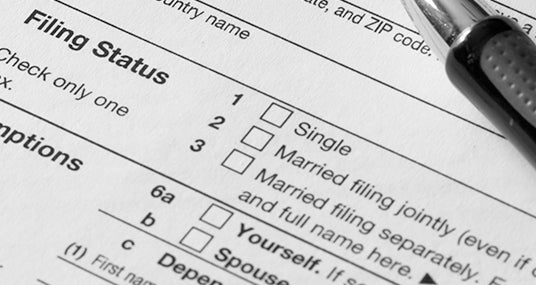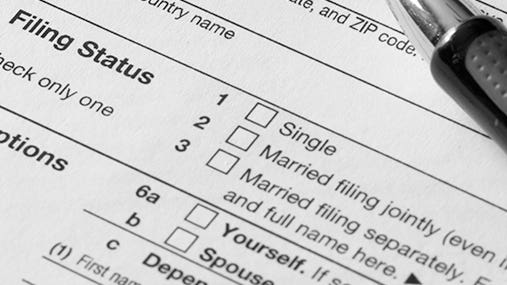

topseller/Shutterstock.com
There are seven tax brackets for most ordinary income for the 2023 tax year: 10 percent, 12 percent, 22 percent, 24 percent, 32 percent, 35 percent and 37 percent.
Your tax bracket depends on your taxable income and your filing status: single, married filing jointly or qualifying widow(er), married filing separately and head of household. Generally, as you move up the pay scale, you also move up the tax scale.
2023 tax brackets (for taxes due April 2024 or October 2024 with an extension)
| Tax rate | Single | Head of household | Married filing jointly or qualifying widow | Married filing separately |
|---|---|---|---|---|
| Source: IRS | ||||
| 10% | $0 to $11,000 | $0 to $15,700 | $0 to $22,000 | $0 to $11,000 |
| 12% | $11,001 to $44,725 | $15,701 to $59,850 | $22,001 to $89,450 | $11,001 to $44,725 |
| 22% | $44,726 to $95,375 | $59,851 to $95,350 | $89,451 to $190,750 | $44,726 to $95,375 |
| 24% | $95,376 to $182,100 | $95,351 to $182,100 | $190,751 to $364,200 | $95,376 to $182,100 |
| 32% | $182,101 to $231,250 | $182,101 to $231,250 | $364,201 to $462,500 | $182,101 to $231,250 |
| 35% | $231,251 to $578,125 | $231,251 to $578,100 | $462,501 to $693,750 | $231,251 to $346,875 |
| 37% | $578,126 or more | $578,101 or more | $693,751 or more | $346,876 or more |
2024 tax brackets (for taxes due April 2025 or October 2025 with an extension)
The IRS has also announced new tax brackets for the 2024 tax year, for taxes you’ll file in April 2025 — or October 2025 if you file an extension. Brackets are adjusted each year for inflation.
For taxes due in 2025, Americans will see the same seven tax brackets for most ordinary income that they’ve had in previous seasons: 10 percent, 12 percent, 22 percent, 24 percent, 32 percent, 35 percent and 37 percent.
| Tax rate | Single | Head of household | Married filing jointly or qualifying widow | Married filing separately |
|---|---|---|---|---|
| Source: IRS | ||||
| 10% | $0 to $11,600 | $0 to $16,550 | $0 to $23,220 | $0 to $11,600 |
| 12% | $11,601 to $47,150 | $16,551 to $63,100 | $23,221 to $94,300 | $11,601 to $47,150 |
| 22% | $47,151 to $100,525 | $63,101 to $100,500 | $94,301 to $201,050 | $47,151 to $100,525 |
| 24% | $100,526 to $191,950 | $100,501 to $191,950 | $201,051 to $383,900 | $100,525 to $191,950 |
| 32% | $191,951 to $243,725 | $191,951 to $243,700 | $383,901 to $487,450 | $191,951 to $243,725 |
| 35% | $243,726 to $609,350 | $243,701 to $609,350 | $487,451 to $731,200 | $243,726 to $365,600 |
| 37% | $609,351 or more | $609,351 or more | $731,201 or more | $365,601 or more |
How do federal tax brackets work? Calculate your effective tax rate
Tax brackets are not as intuitive as they seem because most taxpayers have to look at more than one bracket to know their effective tax rate.
Instead of looking at what tax bracket you fall in based on your income, determine how many individual tax brackets you overlap based on your gross income.
Figuring that out is easier in practice:
- Example one: Say you’re a single individual who earned $40,000 of taxable income in the 2023 tax year. Technically, you’d be aligned in the 12 percent tax bracket, but your income wouldn’t be levied a 12 percent rate across the board. Instead, you would follow the tax bracket up on the scale, paying 10 percent on the first $11,000 of your income and then 12 percent on the next chunk of your income between $11,001 and $44,725. Because you don’t make above $44,725, none of your income would be hit at the 22 percent rate.
That often amounts into Americans being charged a rate that’s smaller than their individual federal income tax bracket, known as their effective tax rate.
- Example two: Say you’re a single individual in 2023 who earned $70,000 of taxable income. You would pay 10 percent on the first $11,000 of your earnings ($1,100); then 12 percent on the chunk of earnings from $11,001 to $44,725 ($4,266), then 22 percent on the remaining income ($5,159).
- Excluding any itemized or standard deduction, your total tax bill would be $10,525. Divide that by your earnings of $70,000 and you get an effective tax rate of roughly 15 percent, which is lower than the 22 percent bracket you’re in.
What is a marginal tax rate?
Another way of describing the U.S. tax system is by saying that most Americans are charged a marginal tax rate. That’s because as income rises, it’s taxed at a higher rate. In other words, the last dollar that an American earns is taxed more than the first dollar. This is what’s known as a progressive tax system.
The technical definition of a marginal tax rate would be the rate that each individual taxpayer pays on their additional dollars of income.
How to get into a lower tax bracket
Americans have two main ways to get into a lower tax bracket: tax credits and tax deductions.
Tax credits
Tax credits are a dollar-for-dollar reduction in your income tax bill. If you have a $2,000 tax bill but are eligible for $500 in tax credits, your bill drops to $1,500. Tax credits can save you more in taxes than deductions, and Americans can qualify for a variety of different credits.
The federal government gives tax credits for the cost of buying solar panels for your house and to offset the cost of adopting a child. Americans can also use education tax credits, tax credits for the cost of child care and dependent care and tax credits for having children, to name a few. Many states also offer tax credits.
Tax deductions
While tax credits reduce your actual tax bill, tax deductions reduce the amount of your income that is taxable. If you have enough deductions to exceed the standard deduction for your filing status ($13,850 for taxes due in 2024 and $14,600 for 2025 tax filings), you can itemize those expenses to lower your taxable income. For example, if your medical expenses exceed 7.5 percent of your adjusted gross income in 2023, you can claim those and lower your taxable income.






